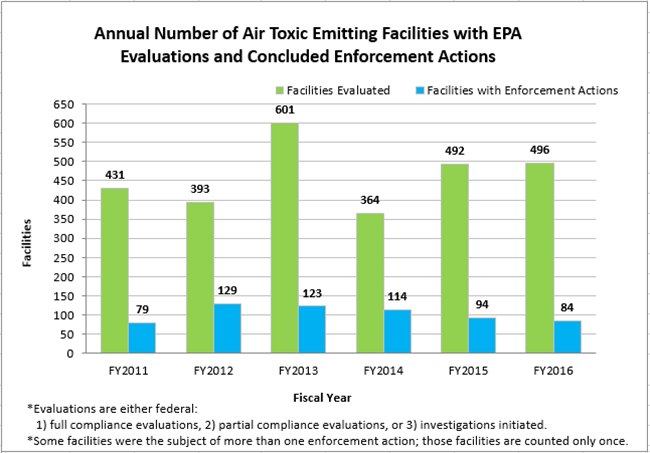National Enforcement Initiatives for Fiscal Years 2014-2016: Cutting Hazardous Air Pollutants
Fast Fact
Enforcement actions in 2010 resulted in reducing lifetime air toxics cancer risk to less than 1 in a million for more than 900,000 people.
Problem
Leaks, flares, and excess emissions from refineries, chemical plants and other industries emit hazardous air pollutants (HAPs), or air toxics, that are known or suspected to cause cancer, birth defects, and seriously impact the environment.
Recent monitoring shows that facilities typically emit more HAP emissions than they actually report.
Leaking equipment and improperly operated flares are some of the largest sources of HAP emissions from petroleum refineries and chemical manufacturing facilities. Improper operation of an industrial flare can result in hundreds of tons of excess HAP emissions.
Hazardous waste air emissions present a potential risk for nearby communities and facility employees. Organic air emissions may present increased fire or explosion risk, and volatile organic air emissions contribute to ground level ozone.
Goal
EPA has worked to identify and address illegal and excess emissions of toxic air pollutants from leaks and flares at facilities that have a significant impact on air quality and health in communities since this initiative began in 2004.
EPA will continue to implement this initiative in fiscal years 2017-19, and expand it to include addressing air emissions from large product storage tanks and hazardous waste generator and treatment, storage and disposal facilities. In doing so, EPA will focus on identifying and addressing violations of leak detection and repair requirements for product storage tanks, and hazardous waste tanks, surface impoundments, or containers, as well as from related hazardous waste treatment equipment.
Progress on Cutting Hazardous Air Pollutants
The following maps and charts show EPA's progress in targeting and reducing illegal emissions of toxic air pollutants.
Map of air toxics enforcement actions


